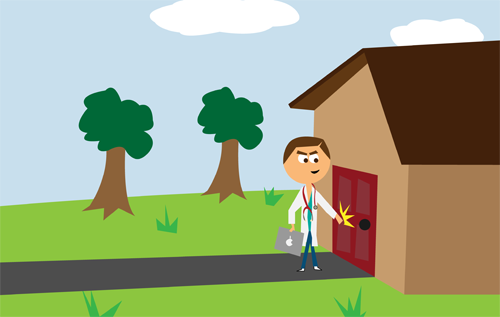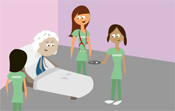
A Doctor in the House
by Patrick Egan and Sharaf Mowjood
The image of the local doctor knocking at the door, black leather bag in hand, is no longer a relic from classic movies. Resuscitating the house call would allow doctors to see elderly patients at home, in an attempt to treat chronic illnesses before they force people into expensive emergency rooms or nursing facilities.
Older Americans consume the greatest proportion of health care dollars, by far. Three out of four people over 65 have multiple chronic conditions, such as hypertension, heart disease and diabetes, according to a recent Robert Wood Johnson Foundation report. People with five or more chronic conditions account for two-thirds of all Medicare spending.
Doctors and nurses on home visits often can do more to treat a chronic condition than write a prescription or take a blood sample. “Within 2 – 3 minutes, doctors at home can spot things” that might exacerbate a problem, says Bruce Leff, a geriatrician at Johns Hopkins University. He gets a better understanding of how regularly patients take medications, for instance, or whether living conditions in the home are sanitary and safe, when he sees patients in their own environments.
Johns Hopkins started its Hospital at Home program after determining that acute-level health care could be delivered economically and effectively at home. Leff worked with a research team studying 455 patients, some treated in hospitals, others receiving care in their homes. On average, the group reported in 2005, a hospital stay cost nearly $7,500 while an equivalent stretch of home care cost $5,081 per episode. The 33 percent savings occurred because home patients required fewer procedures and improved more quickly.
The concept won’t work for all practices. “The question is, why don’t more physicians do house calls if it’s so effective,” says Stephen Rosenthal, chief operating officer of Montefiore Medical Center in Yonkers, N.Y. “It’s a lot more profitable for a physician in a fee-for-service practice to see 50 patients when they all come to see him.” Montefiore has experienced tremendous cost savings because it uses a subscription health care service; its 600 home patients pay a flat rate—the opposite of fee for service.
The Independence at Home Act, part of the health care reform bill, will help answer some of these questions; it provides for pilot house call programs aimed at reducing costs.
Patients express few reservations. Geraldine Bennett was with her 84-year-old mother, Margorit, when Dr. Mohamed Aniff of Montefiore visited them at their home in Co-op City in the Bronx recently. “When I used to take my mother to the doctor, her pressure would be up, she would be so hassled,” Bennett says. During a house call, “she’s in her environment, she’s very comfortable.” Bennett credits house calls with reducing her mother’s hospital visits.
Avoiding a costly emergency-room visit represents a huge payoff, and opening a window into a patient’s life may return the greatest dividends. “From a physician’s perspective, it is a very satisfying experience. I get about 45 minutes with the patient,” says Aniff. “We get to go through everything.”
-

A Way to Ensure Retirement -
Most Americans fail to prepare financially for retirement. One economist has proposed taking the choice out of saving.
-

From Hospital Halls to Cyberspace -
Telemedicine or e-care—technologies including remote patient-monitoring or videoconferencing—may prevent costly emergency room visits, hospital stays and nursing home use.
-

Rethinking Retirement -
For millions of aging workers, the retirement age is sliding further away. Some will have to keep working; others will want to. Analysts ponder ways to make added work years viable and rewarding
-

Curing an Ailing Workforce -
The health care industry needs millions of additional professionals with better geriatric skills to treat a surging older population. Two innovations are making headway.
-

Finding a Home to Grow Old In -
Seniors want to age in place, but most will eventually require care. New senior housing options mix independent living with services as needed.
THIS PACKAGE IN DEPTH
To read about how this story came together and the reporters involved
Click Here.
To see this story as part of a larger package published on Washingtonpost.com
Click Here.